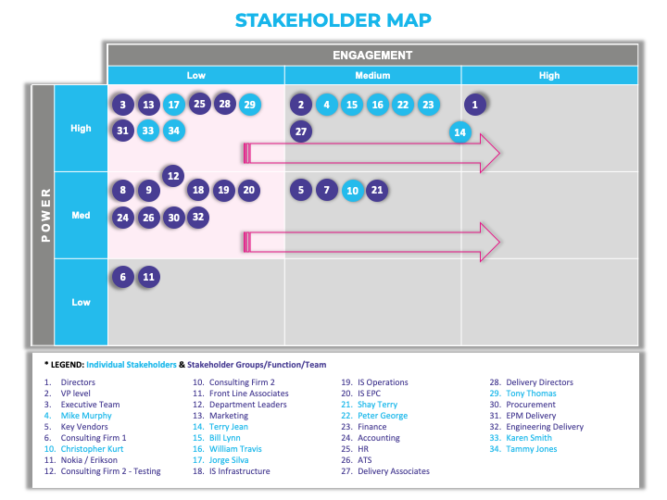October 21, 2024 | How To...
Does your project team use a Stakeholder Map?
A Stakeholder Map is one of the most underutilized and underrated tools in program management. It is a tool used to analyze individuals and groups by the power they hold (impact, influence) and engagement they have with a given initiative in order to drive optimal levels of advocacy and adoption.
Stakeholder Maps are most effective at the earliest stage of an initiative at a time when the relevant stakeholders and their current attitudes are starting to emerge. But it’s never too late to create one for your project or program. It is a dynamic, ongoing tool that should be updated as communication and enablement strategies are deployed.
To create a Stakeholder Map
| 1.) |
Create a map (e.g., table) with three columns and three rows. The horizontal axis indicates engagement/interest level – with sections for high, medium, and low. The vertical axis indicates power – also with sections for high, medium, and low. |
|
| 2.) |
Identify all potential individuals or groups that could be directly or indirectly impacted by a change. This includes internal and external resources (i.e., vendors, suppliers, customers) |
|
| 3.) |
Interview specific stakeholders to gauge engagement level |
|
| 4.) |
Conduct a stakeholder workshop(s) to list, discuss, debate and plot stakeholders across the power and engagement gap axes |
|
| 5.) |
Segment the individuals and/or groups on the map to create specifically labeled groupings |
|
| 6.) |
Develop actionable strategies to reduce engagement gaps |
|
| 7.) |
Develop actionable strategies to leverage individuals identified as medium to high power |
|
| 8.) |
Review and update the map to discuss progress made, introduce new stakeholders, and replace stakeholders no longer in scope |
The information gathered to create a stakeholder map should also be an input to your communication plan. Determine qualities such as a stakeholder’s preferred communication method, frequency, key messaging, message sender, etc. For those familiar with the Prosci methodology, you can also determine what stage the stakeholder is in relative to the ADKAR model (awareness, desire, knowledge, ability, and reinforcement).
One example of how the stakeholder map informs communication:
| • |
Stakeholders with high power and high engagement/interest – communicate with often and win over as advocates |
|
| • |
Stakeholders with high power and low engagement/interest – keep informed and possibly leverage as advocates |
|
| • |
Stakeholders with high power and low interest – keep satisfied with broad communication |
|
| • |
Stakeholders with low power and low interest – monitor and see if shifts occur with this group |
There is no one way or wrong way to create a Stakeholder Map. The important thing is to create it early and update it throughout the lifecycle of the project.






